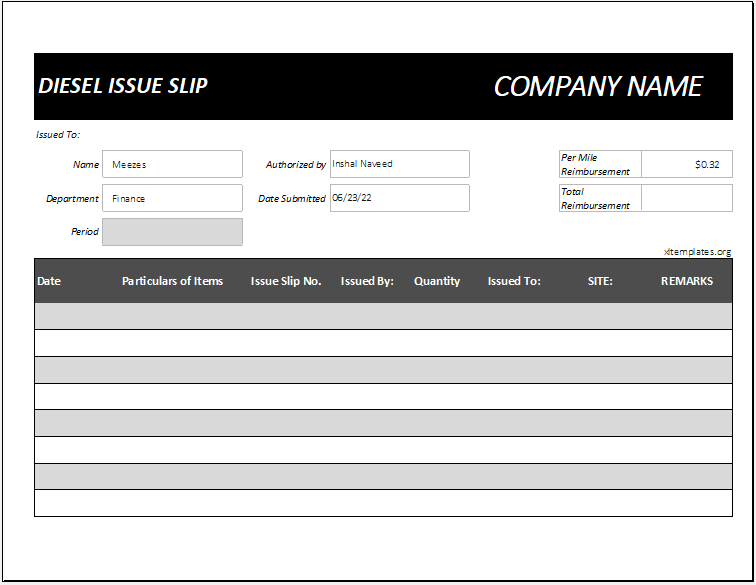
Keeping track of fuel consumption and maintenance is crucial for any business that relies on diesel-powered vehicles or machinery. One tool that can help simplify this process is a diesel issue slip.
This article will explore what a diesel issue slip is, why it is important, and how to effectively use it in your business.
What is a Diesel Issue Slip?
A diesel issue slip is a document used to record the issuance of diesel fuel to specific vehicles or machinery. It serves as a detailed record of fuel consumption, allowing businesses to monitor usage and track expenses. The slip typically includes information such as the date and time of issuance, the quantity of fuel provided, the vehicle or machinery receiving the fuel, and the person responsible for issuing it.
By maintaining a log of diesel issuance, businesses can easily identify patterns, detect any irregularities or discrepancies, and ensure that fuel is used efficiently and responsibly.




Why is a Diesel Issue Slip Important?
There are several reasons why a diesel issue slip is important for businesses:
- Accurate fuel consumption tracking: With a diesel issue slip, businesses can keep a precise record of fuel consumption for each vehicle or machinery. This information is valuable for budgeting, cost analysis, and identifying any excessive fuel usage or potential fuel theft.
- Improved maintenance planning: By tracking fuel consumption, businesses can also identify when vehicles or machinery require maintenance based on usage patterns. This proactive approach helps prevent breakdowns and costly repairs.
- Compliance with regulations: In some regions, businesses may be required to maintain accurate records of fuel consumption for tax or regulatory purposes. A diesel issue slip ensures compliance with these requirements.
- Enhanced accountability: By assigning responsibility for issuing fuel to specific individuals, businesses can promote accountability and discourage any misuse of fuel.
How to Use a Diesel Issue Slip
Using a diesel issue slip is a straightforward process. Here are the steps to effectively utilize this tool:
1. Create or download a diesel issue slip template:
To get started, you will need a template for the diesel issue slip. You can create your customized template or find ready-to-use templates online. Make sure that the template includes all the necessary fields, such as date, time, quantity, vehicle or machinery details, and issuer information.
2. Print enough copies of the diesel issue slip:
Once you have a template, print enough copies of the diesel issue slip to meet your business’s needs. Consider using a carbonless paper or a digital form for ease of record-keeping.
3. Fill out the slip for each diesel issuance:
Whenever diesel fuel is issued to a vehicle or machinery, fill out a diesel issue slip for that transaction. Record the date, time, quantity of fuel, vehicle or machinery details, and the person responsible for the issuance. Make sure to keep the slips organized and easily accessible for future reference.
4. Analyze the data and take action:
Regularly review the data recorded on the diesel issue slips. Look for any patterns, discrepancies, or excessive fuel consumption. If any issues arise, investigate further and take appropriate action, such as addressing maintenance needs or addressing potential fuel theft.
5. Maintain backups:
To ensure the security and integrity of your data, create backups of the diesel issue slips. Consider digitizing the slips or storing physical copies in a safe and organized manner.
Tips for Successful Use of Diesel Issue Slips
Here are some tips to ensure successful use of diesel issue slips:
- Proper training and communication: Train employees on how to correctly fill out the diesel issue slips and explain why accurate record-keeping is crucial. Ensure that there is clear communication about the importance of fuel efficiency and responsible fuel usage.
- Consistency in record-keeping: Encourage consistency in recording diesel issuances by implementing a standardized process and providing clear instructions. Consistent record-keeping ensures accurate data analysis.
- Regular data analysis: Set up a system for regularly analyzing the data from diesel issue slips. Look for trends, identify areas for improvement, and take prompt action when necessary.
- Integration with other systems: Explore opportunities to integrate the data from diesel issue slips with other systems or software used in your business. This integration can streamline processes and provide a more comprehensive view of fuel consumption and maintenance needs.
By implementing a diesel issue slip system and following these tips, businesses can effectively monitor fuel consumption, improve maintenance planning, and ensure compliance with regulations. This tool empowers businesses to make data-driven decisions and optimize their diesel usage, leading to cost savings and improved operational efficiency.
Diesel Issue Slip Template Excel – Download